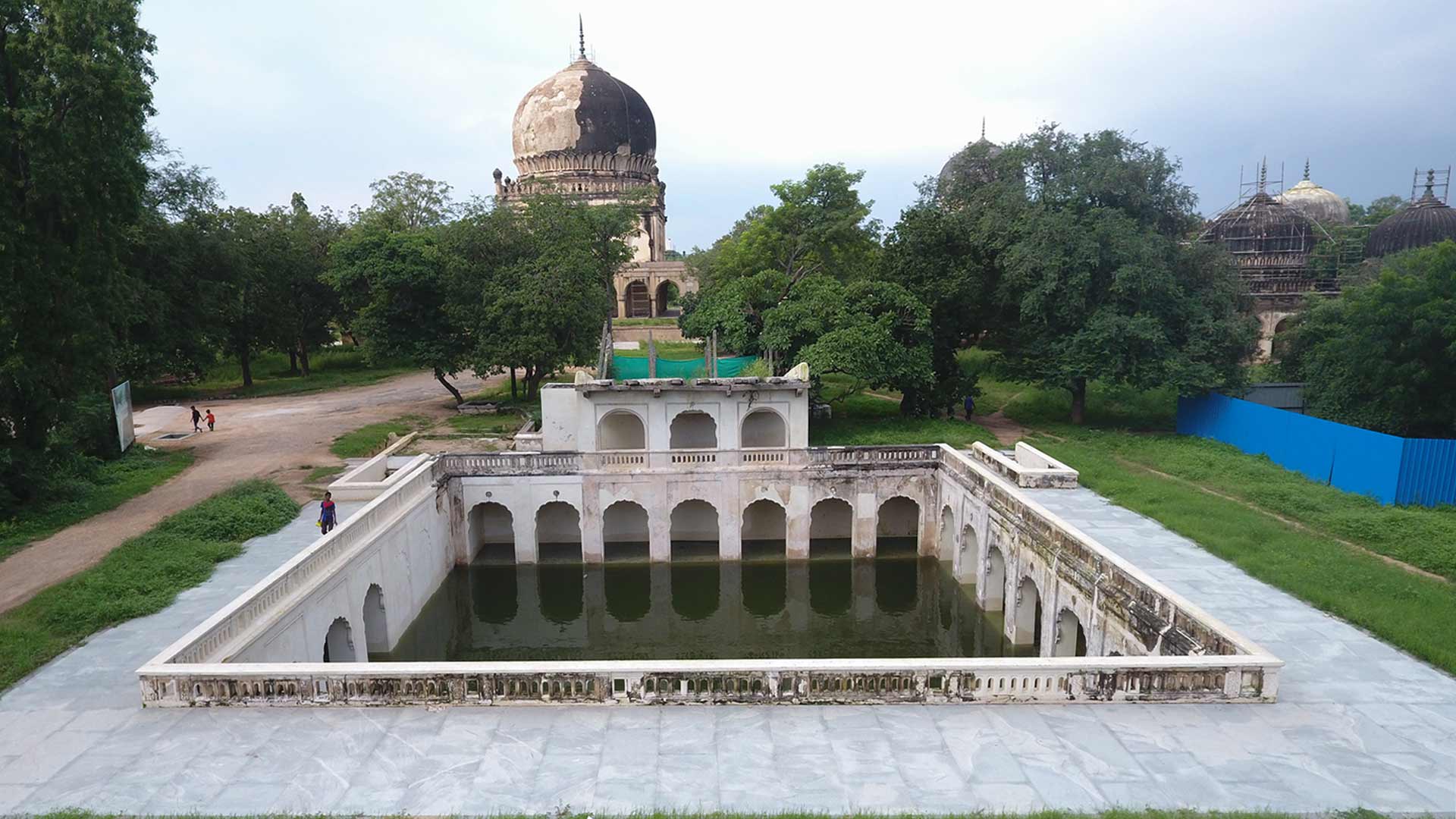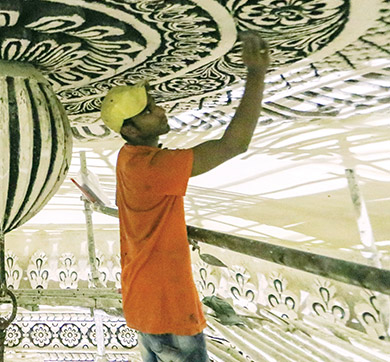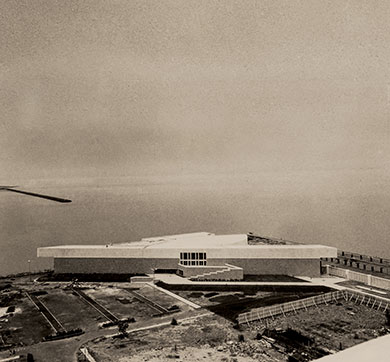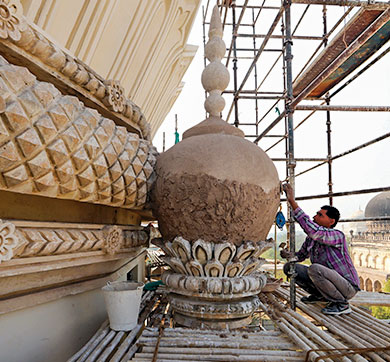July 2023 | 1204 words | 5-minute read
In 2012, Tata Trusts entered into a partnership with Aga Khan Trust for Culture (AKTC) to restore nine major monuments within the Qutb Shahi Heritage Park in Hyderabad.
The project was initiated upon the successful completion of the conservation of Humayun’s Tomb in Delhi (also supported by Tata Trusts and implemented through AKTC). Having established a crafts-based approach to conservation, the conservation of the nine monuments was carried out over an eight-year period following best practices, including documentation, archival research, peer reviews of conservation plans, and employing a multi-disciplinary team including skilled craftsmen, engineers and conservation architects. The nine monuments conserved in the project comprised 6 royal tombs of the Qutb Shahi dynasty, the Great Mosque (Funerary Mosque of Hayat Baksh Begum), a Hamam or bath-house, and the Badi Baoli or ‘big stepwell’.
In November 2022, the UNESCO Asia-Pacific Awards for Cultural Heritage Conservation recognised the conservation work of the five restored stepwells within the Qutb Shahi Heritage Park – an effort of ten years by AKTC, supported by Tata Trusts, as well as the US Ambassadors Fund for Cultural Preservation.
This is the story of the restoration of the Badi Baoli, whose conservation was supported by Tata Trusts, that was revived to its former glory from the brink of total collapse.


Legacy of stepwells in India
Stepwells are architectural marvels that served a purpose beyond that of water conservation and management – they were socio-religious monuments, that, over its long history dating to the ancient civilisations, became important structures oftentimes built through patronage of ruling dynasties as providing a perennial source of water was a key accomplishment for any ruling kingdom.
Stepwells can be found in abundance in India dotting urban and rural landscapes. Disused since the 19th century when the British introduced tap and pipe connections for water supply, a majority of stepwells are now neglected monuments with crumbling structures, littered water catchments and illegal encroachments. Over the centuries, the design of stepwells has become more sophisticated with the ‘golden period’ of stepwells, so to speak, during the medieval period. Made with traditional building materials that were locally available, stepwells allowed access to water for the community, a space for ‘cooling down’, water for irrigation and agriculture, as well as drinking. Stepwells were often built with great depth to tap the perennial water table underground, and the series of steps, colonnades and corridors ensured that direct sunlight didn’t reach the water catchment, preventing its drying up during the summer season. Stepwells were built in different geometric shapes as well, using architectural motifs that were symbolic of the community’s socio-religious composition. Known with different names – baoli, bawdi, baori, pushkarni, kalyani, kund – stepwells are still commonly referred to, even as cities have emerged around it, sometimes allowing it the space it deserves, and sometimes filling them up leaving little evidence of their existence.

Unearthing the past
The Badi Baoli, that literally translates as the ‘big stepwell’ is one of six historic stepwells located at the Qutb Shahi Heritage Park. Dating to the 17th century, the Baoli was found to be structurally unstable during the documentation phase in 2011, when portions of the structure suffered minor collapses. AKTC conducted thorough archival research to understand, as far back as possible, the original details of the monuments in the heritage park. Several archives were scoured and over 500 archival photographs of the site were collected to study, and plan for, conservation. In the case of the Baoli, it was discovered that the arcade that forms an integral part of the Baoli as it stands, was a 19th century addition. This retrospective addition had inadvertently blocked the natural drainage outlets of the Baoli, leading to an incremental increase in water pressure over centuries that eventually proved catastrophic.
However, before the conservation works could be commenced on the Baoli, in early 2013 a Wakf Tribunal order halted any engagement citing that the 106-acre site was under the protection of the Wakf Board. While the matter was being resolved between AKTC, the Dept. of Heritage Govt. of Telangana and the Wakf Tribunal, repeated and heavy monsoons battered the Baoli and finally its entire western façade collapsed. Conservation works could only commence in November 2013 following a negotiated permission from the Wakf Tribunal.

A labour of care and expertise
The collapse of the western wall of the Badi Baoli delayed the actual conservation work by several months. The first major challenge, spread across 4000 man-days of work, involved the removal of 450 cubic meters of stone debris and silt being lifted from a depth of about 21 metres. The stone that was lifted out was cleaned of mortar and kept for re-use in the reconstruction of the collapsed wall. About 2,00,00,000 litres of water was also pumped out of the Baoli catchment and fed into the other stepwells. The removal of the stone blocks revealed the friable condition of the rock underneath and necessitated the laying of a reinforced concrete base on which the masonry could be re-built.
In order to allow water flow into the Baoli without exerting pressure on the masonry, several weep holes were retained in the masonry. 600 cubic metres of masonry was rebuilt by 2014-15. The Baoli was re-built using traditional lime mortar, which was the material-of-choice of the Qutb Shahi builders, and during restoration sufficient time was given to allow the lime mortar to set and gain strength prior to adding additional layers.


The adjoining arcade of the Baoli was reconstructed based on documentation carried out prior to the wall collapse. The plaster patterns found on the parapet were also restored. After completing the reconstruction of the collapsed portion, the cement pointing on the eastern, northern and southern wall surfaces of the Baoli was removed and replaced with lime mortar – to allow any water ingress into the Baoli.
The dramatic collapse of the Badi Baoli would’ve seemed permanent to many, considering not just the extent of masonry that had crumbled, but also the withered rock face that was revealed underneath. But following best practices involving relying on the strength of Indian building craft tradition coupled with advanced scientific analysis, the repair of the Badi Baoli was finally completed by 2016.

Sustainable conservation
The conservation efforts extended beyond the stepwell itself to the surrounding landscape. The catchment area of the Badi Baoli underwent grading of earth and the planting of fruit orchards. Today, the stepwell stands as a reservoir, holding over 33 lakh litres of rainwater that is used to prepare lime mortar for the conservation works as well as the landscaping efforts, helping save annual water carriage costs to the site.
In January 2017, the completion of the restoration of the Badi Baoli was celebrated in a ceremony that was attended by Telangana government officials invested in the project, as well as the general public, highlighting not only the restored stepwell, but also the partnership between AKTC and the Govt. of Telangana for the conservation project, that received support from Tata Trusts.
Teeming with fish, the Badi Baoli is a major attraction at the Qutb Shahi Heritage Park. General visitors, students, cultural organizations, civil society groups, conservation professionals, policy makers make regular visits to learn from the conservation effort and hopefully, replicate the learnings at other stepwells.
Source: tatatrusts.org, June 28, 2023
































